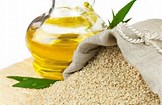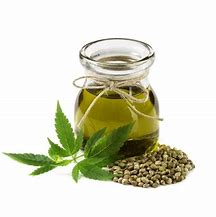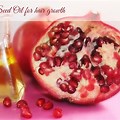Sesame Oil




Sesame OIl
- Latin Name
Sesamum indicum DC
Family: Pedaliaceae - Etymology
From the arabic simsim, the Coptic semsem and the Egyptian semsemt. Also known as gingelly (or gingili) oil, teel oil, benne oil and thunderbolt oil. Sesame is mentioned in the Ebers Papyrus which dates from about 1800 BC. In Hindu mythology sesame relates to the god Yama, the judge of the dead, and as the symbol of mortality.
- The Plant and its environment
The sesame plant, originating from the tropical regions of the East Indies, is an upright annual with long bell-like flowers resembling those of the foxglove. The flowers are white with just a tinge of red, blue or yellow. The seeds are difficult to harvest as the keel shaped seed pods shatter easily , so they need to be gathered by hand. However, there are now several different modern varieties, varying in height from 0.6-2.5 metres (2-8 feet) which allow machine harvesting. - As a result, sesame is grown world wide, especially in China, India, Africa and South America (where it was introduced by the Portuguese ). Sesame has been cultivated for at least 4000 years in Mesopotamia and is documented somewhat later in India and China. Sesame was one of the plants found in the tomb of Tutankhamun 1370-1352 BC (Chevallier 1996).
- The hulled seeds are waxy, measuring approximately 3mm in length, with a shape like a flat teardrop. Their colour varies from white, through reddish brown to black; in fact, they are known commercially as 'white and black' .The white seeds yield the superior oil. The seeds escape spontaneously from the ovary at maturity and this may be the source idea behind Ali Baba's exclamation in the Arabian Nights - 'Open sesame'.
- The Oil
The oil has properties similar to Olive oil. It is very stable as it contains a natural antioxidant system made up of sesamol and sesamolinol formed from sesamolin; these reduce the rare oxidation significantly (Hughton 1995). - Method of Extraction
The seed contains up to 55% oil and the best grade is obtained by single cold pressing and filtering. It is a pale yellow colour. A lesser quality oil is available which has been hot pressed at high pressure and then refined and deodorized before being suitable for use. Most sesame oils have some colour and sometimes they are bleached , but such oils tend to be somewhat acid.
Principal Constituents
| Type | Based on | Content - % | |
| Saturated fatty acid units | |||
| C14:0 | myristic acid | <0.5 | |
| C16:0 | palmitic acid | 7.0-12.0 | |
| C18:0 | stearic acid | 3.5-6.0 | |
| C20:0 | arachidic acid | <1.0 | |
| C22:0 | behenic acid | <0.5 | |
| Typical saturated fatty acid unit content | 16 | ||
| Monounsaturated fatty acid units | |||
| C16:1 | palmitoleic acid | <0.5 |
| C18:1 | oleic acid | 40 (35-50) |
| C20:1 | eicosenoic acid | <0.5 |
| C22:1 | erucic acid | <0.1 |
| Typical monounsaturated fatty acid unit cxontent | 40 | |
| Polyunsaturated fatty acid units: | ||
| C18:2 | linoleic acid | 44 (35-50) |
| C18:3 | alpha - linolenic acid | <1.0 |
| Typical polyunsaturated fatty acid unit content | 44 | |
| physical properties | almost odourless | |
| Odour |
| Acid value | 0.3 max | |
| Specific gravity | 0.915-0.925 | |
| Energy value Kcal/100ml | 898 |
- Folk-lore and traditional uses
These seeds are helpful in cases of constipation and, when ground up with water, can be used to treat haemorrhoids. In India a liquid extract is made by boiling the seeds with water to use as an emmenagogue (Stuart 1987). Sesame oil may be used as a drug solvent. The cosmetic industry uses an extract as an antioxidant, radical scavanger and regenerating agent (Bruneton 1995). - The seeds were ground in ancient Egypt to produce a flour and today throughout the east and the Mediterranean they are made into a paste called tahini, supposed to give long life. The women of ancient Babylon ate halva, a mixture of sesame and honey, to retain their youth and beauty; Roman soldiers mixed sesame seeds with honey for energy during their campaigns.
- Therapeutic Properties - Internal use
Sesame oil is said to improve the blood platelet count and combat anaemia (Bartram 1996). It is said that 20 drops taken daily double the count in children in three to four weeks. It is also said to be effective against spleen disorders. The oil is soothing to the digestive tract (high in calcium, not acid forming) and is a mild laxative. - Therapeutic Properties - external use
excellent for massage when used around 20% in the base carrier
beneficial for rheumatic and skin conditions
in Scandinavia for psoriasis, dry eczema, broken veins (Thomsen 1986). - Therapeutic Properties - external use
excellent for massage when used around 20% in the base carrier
beneficial for rheumatic and skin conditions
in Scandinavia for psoriasis, dry eczema, broken veins (Thomsen 1986).
- Cosmetic use
Sesame oil is used in brilliantine, sun screens, shampoos, soaps and lubricating creams. Mixed with olive oil it can be used to counteract dandruff. - Culinary use
- The natural oil does not have a definite taste and is suitable for flavoured dips, salad dressings and deep frying. Toasted sesame oil is also available and is used to add flavour to salad dressings and eastern dishes. Both tahini and halva are now available in some supermarkets and stores.
- Cautionary notes
Sesame oil has been reported as causing hypersensitivity (Torsney 1964). - Reference: Carrier Oils/ Len Price et al
Articles-Most Read
- Home
- Contact Us
- Coconut Oil-2
- Absorption Ratings for Carrier Oils
- Cold Pressing Method
- What are Essential Fatty Acids
- Cherry Kernel Oil
- Fixed Oils and Skin Penetration
- Hempseed Oil
- Almond Oil
- Cocoa butter
- Camelina Oil
- Coconut Oil
- Antibacterial Effects Of Carrier Oil
- Lime Blossom Oil (macerated)
- Carrot Oil, Wild Carrot Oil (macerated)
- Apricot Kernel Oil
- Kukui Nut Oil
- Jojoba Wax
- Pumkin Seed Oil - Cucurbita maxima, C. pepo
- Passion Flower OIl (Macerated)
- Hydrocotyle Oil (macerated)
- Palm Kernel Oil
- Rapeseed Oil - Carrier Oil
- Nutrients
Who's On Line
We have 143 guests and no members online
Articles-Latest
- How to Make Homemade Olive Oil: A Step-by-Step Guide
- 20 Evidence-Based Aloe Vera Oil Benefits For Skin, Hair & Health
- Peanut oil - Cold pressed - Are There Health Benefits? How To Make
- What Are the Health Benefits of Black Seed Oil?
- Comfrey oil Infused
- Chamomile Flowers Infused Oil
- Calendula Flowers Infused Oil
- Arnica Flowers Infused Oil
- How To Make Herb-Infused Oils
- DIY avocado oil for healthy skin
- How To Make Coconut Oil
- 8 Benefits of Mustard Oil, Plus How to Use It
- SHOREA STENOPTERA SEED BUTTER
- Shea Butter- 7 Amazing Benefits Of Shea Butter
- Monoi Oil For Hair & Skin
- Mango Seed Oil
- Cohune Oil Is The Next Big Thing
- Brazil Nut OIl
- 7 Impressive Benefits Of Allspice
- Camelina Oil Benefits, Uses, and Side Effects




